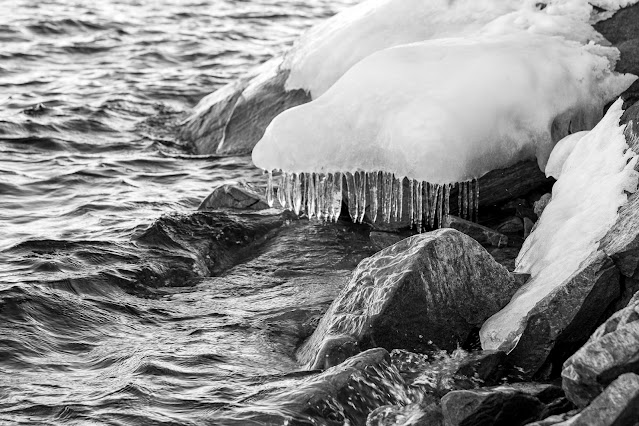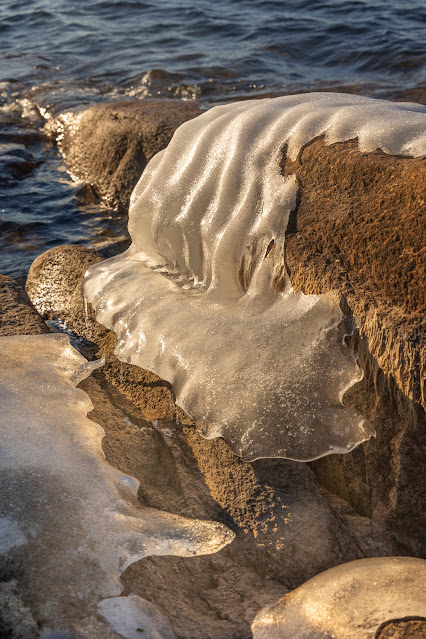When the Art of Winter program by creative photographer Chris Murray was announced, there were justifiably visions of snowy forests with stark birch tree stands and graceful glacial drumlins across the land. The hope was to find scenes like my March 2021 image at right of Cayuta Outlet near my home. Sadly the Thousand Islands this year in February had scant snow cover.
The three days were going to be challenging, yet that might actually turn out to be a better learning opportunity. There arrives a call to more deeply observe and really understand what draws your interest. What follows are a selection of images that offer enjoyment and hopefully also ideas for coping with rainy days, dull light and otherwise disappointing situations. Hasn't that happened to everyone?
On one morning we went to Dewolf Point State Park on Wellesley Island. It is on a bay with only a very narrow connection to the main river. Unlike most river areas, the bay is largely immune to river currents, so there was plenty of good ice. Arriving shortly before sunrise, two fishermen were soon loading their sheds. We'd walked out to a line of summer cabins facing the expected sunrise. The view did not impress me. As I walked back to another view with a stately red cedar, the sound of the anglers' sheds crunching on the ice suggested they were on a path towards the point of the sun's appearance. Backtrack quickly! The sun can't be delayed. See this!
There were two images to select. When they were standing, the man's head on the right touched the dark treeline. Creatively, it's called a conjoined element and is to be avoided. Later, there were more fishermen on the ice but the missing starburst lowers the result to ho-hum.
Once my gear was packed and I climbed the path from the view, there was warm sunlight bathing one of the summer cabins along the path. Not wanting the open my pack again, the iPhone was pulled out. This is an excellent time to ask the simple question, "what drew you to take an image?" I hope you say something about the warm light on the line of icicles across the roof line of snow and also in the brilliant window reflections.
That was the answer for me. I am guessing this cabin is already reserved for most weeks in the summer. Another thought is that a quick photo sure beats just ignoring the opportunity.
Winter is also a rich source of beautiful monochrome images. The next setting drew my interest as I saw this large snow capped rock with a fringe of icicles dipping towards the St. Lawrence River's waves. Many photos were run in continuous batch to get the best shape on the water.
In other years, the river would be all ice and the wave shapes and fringes on the rock missing. It's really a very simple photo.
The ice along the river builds forms often dependent on wind direction and the rock formats. Here's another situation where the ice laid up a scalloped pattern.
The real challenge for the above was getting into the narrow trough of rocks where the forms were free of distractions (and then climbing back up after my one leg fell asleep!)
The next image presents a contrast between a geological form and a seasonal form. Hard rock and hard ice drew my interest.
I saw a sort of yin-yang pairing that was better in black & white.
Later that morning at Dewolf Point, our leader took us to a long spine of hard rock that paralleled the northeast lay of the bay. I conjecture that the spline resisted the glacial assault that excavated the bay. Here's a wide view of the wall of rock exposed.
The panoramic image distorts the shape of the wall. It's nearly horizontal on the top. The height is close to 20 feet. One could spend a long day exploring the many patterns in the the stone. The section below fascinated me.
So, I looked more closely and explored what I interpreted as a tree in a violent turmoil, perhaps a firestorm. The large tree is in the far left and flames swirl away in a maelstrom.
That morning was surprisingly rich with ideas. The afternoon was a bit challenging until the sun collided with a distant shore of the St. Lawrence River. Not any clouds, but a nice starburst framed by a nearby point.
The final morning sunrise was a bit richer when some wispy clouds appeared to capture the warm hues.
In terms of whiz-bang images, it was not easy. But, measuring the lessons gained absent any "easy", it was extremely valuable. I am not at all hesitant to share these images. In every one, there is a clear reason why the subject was chosen and how it was arranged in the overall location. You cannot see what was excluded carefully to avoid any viewer confusion. Success is knowing what to take and what to leave behind. That's a line from a John Denver song "Friends with You."
Learning usually comes from challenges.
Hope you enjoy the message.
Paul Schmitt






















